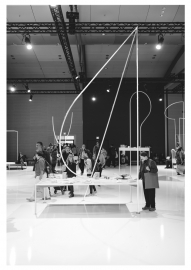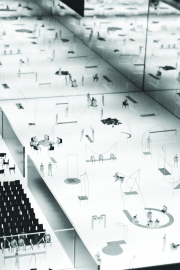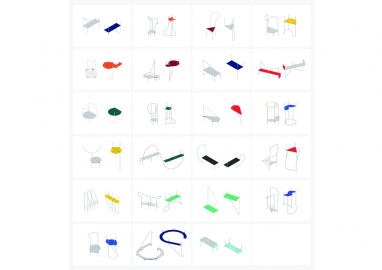Frankfurter Buchmesse - Guest of Honour
The Guest of Honor Pavilion represented Norway in the Frankfurt Book Fair.
The pavilion was about literature as space and materialized ideas contained in Norwegian literature and literary production. The furniture and public venues supported writers, readers, and books and was visited by 302 267 people.
The Frankfurt Bookfair is the world's largest trade fair for books. The Guest of Honor Pavilion, which was erected inside the large Panorama hall, consisted of a large exhibition space with twenty-two sculptural pieces of furniture, two scenes, a library and book collection with reading area and a small café. The existing space was divided in two by a single wall clad in pine plywood. The wall created a large exhibition- and performance-space without daylight and a space for reading and public mingling flooded in light from the large panorama window. The sculptural furniture was made in raw aluminum which was partly polished and partly painted. The white high-gloss floor and mirror curtains reflected the evocative forms and subtle coloring of the furniture.
The main challenge of the project was to create a feeling of entering an unexpected world with a distinct spatial and architectural character inside the pragmatic structure of the Panorama hall. To achieve this, and at the same time facilitate for parallel performances at the two stages and a very large number of visitors, a robust and flexible concept was required. The very simple plan, the active use of existing daylight, and the freestanding sculptural furniture were means that was used to solve the task. The architectural idea: to use concepts from Norwegian poetry and the Norwegian literary world as a point of departure for the design of unique pieces of furniture, led to a series of evocative and strangely familiar characters. The twenty-two pieces all have names: Table for the Literary System, Table for Fairytales, the Sami Table, Table for Forbidden Books, the Poetry Table, the Nordic Noir Table, the Smell Table etc. The pieces became gravitational points in the large open space where the visiting public could look at books, find information and meet editors and writers.
The Guest of Honor pavilion being an ephemeral structure it was implicit in the brief that the design was going to be short lived. However, the design team found it unsustainable to spend a large amount on a short-lived solution and argued for permanent components that could be reused. The raw aluminum for the tables was chosen for its material properties: light weight, formability and little waste when recast. The tables, including the forming of the large tubular curves of the pieces, were made in Germany after a Norwegian-made prototype. The different pieces were welded and then bolted together. The constraint for the size of the structures was the very large elevator in the Panorama hall, hence the largest table was approximately 5,2 m tall and 4,8 x 5,8 m wide. After the book fair, the life of each piece persists as the tables have been given to German and Norwegian literary institutions and placed inside or outside for the enjoyment of the public.

 © Kristoffer Sekkelsten
© Kristoffer Sekkelsten
 © Luis Callejas
© Luis Callejas
 © Luis Callejas
© Luis Callejas
 © Kristoffer Sekkelsten
© Kristoffer Sekkelsten
 © Luis Callejas
© Luis Callejas



